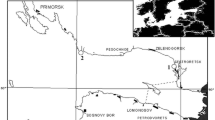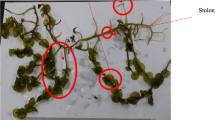Abstract
In order to promote the use of sub-Antarctic macroalgae as food, four species of marine macroalgae: Macrocystis pyrifera, Durvillaea antarctica, Pyropia columbina, and Callophyllis variegata were studied for their nutritional value. They were collected monthly between October and December 2012 throughout the Strait of Magallanes, sub-Antarctic Chile. The chemical composition, including carbohydrates, proteins, lipids, and vitamins A and C, and the macronutrient, mineral, and fatty acid content were examined. Ash (15.1–34.1 %) and soluble fiber (26.5 to 40.3 %) were the most abundant in these species. Presence of protein was moderate (8.2–25.0 %), with red alga (C. variegata) having the highest value on dry weight (dw). All algal species had lipid contents of less than 5 % dw. Maximum carbohydrate content was observed in P. columbina (9.5 % dw). Potassium was the most abundant essential element found in M. pyrifera (8.51 % dw), while P. columbina was found to be richest in iron (305.5 ± 5.5 μg g−1 dw) and C. variegata showed the highest contents of Cu (17.4 ± 0.7 μg g−1 dw). The most abundant saturated fatty acids were palmitic (C16:0) and myristic acid (C14:0), with values ranging from 4.33 to 9.22 %. The most abundant monounsaturated fatty acid was oleic acid (C18:1ω9). The highest levels of polyunsaturated fatty acid were observed for arachidonic (20:4ω6) and eicosapentaenoic acid (C20:5ω3) or EPA.

Similar content being viewed by others
References
Abbott IA (1978) The uses of seaweeds as food in Hawaii. Econ Bot 32:409–412
AOAC (2007) Official methods of analysis of AOAC International, 18th edn. AOAC International, Gaithersburg
Arasaki S, Arasaki T (1983) Vegetables from the sea. Japan Pub., Tokyo
Ávila MS, Saavedra MI, Toledo G et al (2001) Perfiles Nutricionales de Algas Chilenas: Generación de fuentes alternativas de materias primas para la alimentación de especies acuícola, basados en productos algales: I Peces. Proyecto FONDEFD01I1046, Conicyt, Chile
Darcy-Vrillon B (1993) Nutritional aspects of the developing use of marine macroalgae for the human food industry. Int J Food Sci Nutr 44:23–35
Dillehay TD, Ramírez C, Pino M, Collins MB, Rossen J, Pino-Navarro JD (2008) Monte Verde: seaweed, food, medicine, and the peopling of South America. Science 320:784–786
Frikha F, Kammoun M, Hammami N, Mchirgui RA, Belbahri L, Gargouri Y, Miled N, Ben-Rebah F (2011) Chemical composition and some biological activities of marine algae collected in Tunisia. Cienc Mar 37:113–124
Kuda T, Taniguchi E, Nishizawa M, Araki Y (2002) Fate of water soluble polysaccharides in dried Chorda filum, a brown alga, during water washing. J Food Compos Anal 15:3–9
Lahaye M (1991) Marine algae as sources of fibers: determination of soluble and insoluble dietary fiber contents in some sea vegetables. J Sci Food Agric 54:587–594
Mansilla A, Avila M (2011) Using Macrocystis pyrifera (L.) C. Agardh from southern Chile as a source of applied biological compounds. Rev Bras Farmacogn 21:262–267
Mansilla A, Avila M, Yokoya Nair S (2012) Current knowledge on biotechnological interesting seaweeds from the Magallanes Region, Chile. Rev Bras Farmacogn 22:760–767
Matanjun P, Mohamed S, Mustapha NM, Muhammad K (2009) Nutrient content of tropical edible seaweeds, Eucheuma cottonii, Caulerpa lentillifera and Sargassum polycystum. J Appl Phycol 21:75–80
McDermid KJ, Stuercke B (2003) Nutritional composition of edible Hawaiian seaweeds. J Appl Phycol 15:513–524
Merill AL, Watt BK (1973) Energy value of foods: basis and derivation. United States Department of Agriculture, Washington, DC
Murugaiyan K, Narasimman S, Anatharaman P (2012) Proximate composition of marine macro algae from Seeniappa Dharka, Gulf of Mannar region, Tamil Nadu. http://urpjournals.com/tocjnls/37_12v1i1_1.pdf. Accessed 15 June 2013
Narasimman S, Murugaiyan K (2012) Proximate composition of certain selected marine macro-algae forms Mandapam Coastal Region (Gulf of Mannar), Southeast Coast of Tamil Nadu. http://www.ijpba.info/ijpba/index.php/ijpba/article/view/. Accessed 15 June 2013
Nelson MM, Phleger CF, Nichols PD (2002) Seasonal lipid composition in macroalgae of the northeastern Pacific Ocean. Bot Mar 45:58–65
Perez V (2000) Cronología de antecedentes para la Historia de las Ciencias Naturales de la Región de Magallanes: siglo XVI al XIX. Universidad de Magallanes, Punta Arenas
Polat S, Ozogul Y (2008) Biochemical composition of some red and brown macroalgae from the northeastern Mediterranean Sea. Int J Food Sci Nutr 59:566–572
Public Health Institute of Chile (1998) Protocols of the manual of physicochemical analysis of food, water and soil. Ministry of Health, Santiago
Ricketts TR (1966) On the chemical composition of some unicellular algae. Phytochem 5:67–76
Rozzi R, Massardo F, Berghofer A, Anderson C, Mansilla A, Berghofer U, Jax K (2008) Changing lenses to assess biodiversity: patterns of species richness in sub-Antarctic plants and implications for global conservation. Front Ecol Environ 6:131–137
Rozzi R, Armesto JJ, Gutiérrez JR et al (2012) Integrating ecology and environmental ethics: earth stewardship in the southern end of the Americas. BioScience 62:226–236
Villares R, Puente X, Carballeira A (2002) Seasonal variation and background levels of heavy metals in two green seaweeds. Environ Pollut 119:79–90
Acknowledgments
The authors would like to thank the Regional Government for the funding through the Innovation Fund for Competitiveness to the Project “Sub-antarctic macroalgae opportunities for Gastronomic Tourism and Artisan Fishery” BIP Code: 30111118 and “Transfer of healthy eating based on subantarctic macroalgae” BIP Code: 30127816 and S. Murcia for editing the English usage throughout the text.
Author information
Authors and Affiliations
Corresponding author
Rights and permissions
About this article
Cite this article
Astorga-España, M.S., Mansilla, A. Sub-Antarctic macroalgae: opportunities for gastronomic tourism and local fisheries in the Region of Magallanes and Chilean Antarctic Territory. J Appl Phycol 26, 973–978 (2014). https://doi.org/10.1007/s10811-013-0141-1
Received:
Revised:
Accepted:
Published:
Issue Date:
DOI: https://doi.org/10.1007/s10811-013-0141-1




